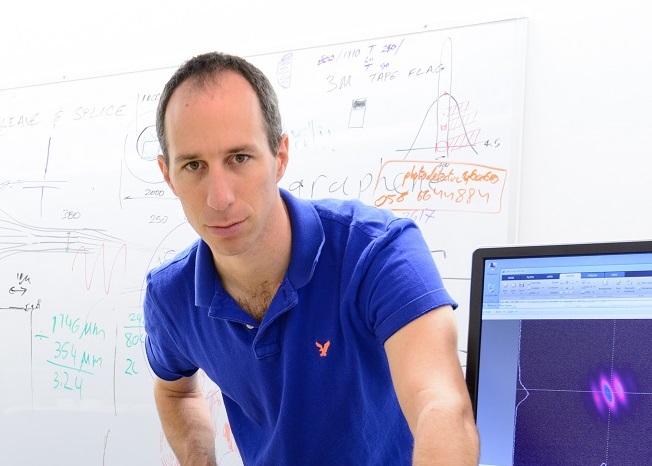Playing with Time

After successfully cloaking a short event in time during his Post Doc, Dr. Moti Fridman is using temporal optics to develop advanced temporal technologies.
Science fiction literature is inundated with time travel and time manipulation stories. It’s only science fiction, of course. But Dr. Moti Fridman, a 38 year old father of two kids, has managed to manipulate time in real life. By combining linear and nonlinear optics, Fridman made a 50 picosecond long event disappear. “Normally, you manipulate light by processing it using spatial elements such as glasses, lenses, etc. I perform the processing in time,” explain Fridman. This field of research is called Temporal Optics, and though it is currently still being developed, it might revolutionize the field of optics. When utilizing the time dimension there are innovative optical tools which do not exist in space, leading to novel optical processing devices, and that’s where we are aiming for: applying temporal optics to optical data processing. It would create an alternative approach to solving problems that are currently considered impossible to solve.”
Fridman, who specializes in temporal optics and fiber manipulation, began his academic career as an undergraduate student of Physics and Computer sciences at Bar-Ilan. He than moved on to the Weizmann Institute of Science, where he completed an MSc and a PhD in Physics, followed by a Post Doc in Applied Physics at Cornell University. “Before leaving for Cornell I heard that the Faculty of Engineering at Bar-Ilan University was recruiting optics experts, and I knew that this was where I wanted to end up,” remembers Fridman. “It is a young, interesting faculty, with great people, some of whom I had already met. So when the offer came to join here, it was at the top of my list. I had other options, but this was my first choice. For me, working here, with this group of people, every single day, is a pleasure.”
For Fridman, electro-optics began with fiber optics. “I was working on coupling lasers, and was able to increase the maximal number of lasers coupled from four to twenty five,” shares Fridman. He was introduced to the field of temporal optics during his Post Doc at Cornell, and decided this would be his main focus. The advances made in the field, he says, are rapid, and their potential – immeasurable. “We still can’t delete events from the past using this technology since we currently can only handle fractions of seconds. However, we can apply temporal optics to short signals and optical data processing. Temporal encryption and temporal cloaking, for instance, can revolutionize the architecture of modern networks and multiply the amount of data transmitted through a network by a thousand times. ”
Fridman established his lab at the Faculty of Engineering only four years ago, but since then he has been focusing on turning optical clocking into an applicable technology. “The gap-in-time demonstration at Cornell was exciting but not very applicable. At Bar-Ilan, we were able to create more practical temporal optic techniques, in order to develop devices for the processing of optical data. This past year we registered a patent on the technology and provided proof of concept, but there is much more work to be done, and I am looking for excelling students who share my passion of developing the technologies of the future. I believe that temporal optics can revolutionize science. We successfully demonstrated cloaking with temporal optics, but there are endless possibilities for applying this technology.”
Last Updated Date : 04/12/2022



